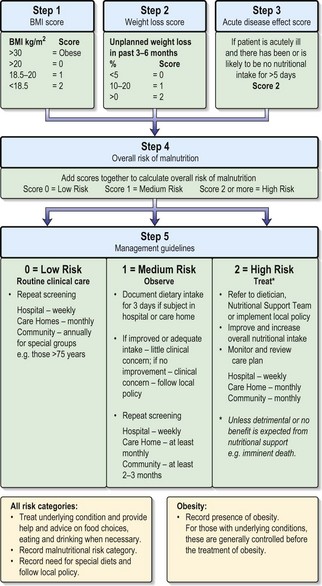4 Nutrition
Dietary requirements
Energy
The estimated ‘average’ daily requirement is:
Protein
Protein contains many amino acids.
Fat
Dietary fat provides 37 kJ (9 kcal) of energy per gram. A high fat intake has been implicated in the causation of cardiovascular disease, cancer (e.g. breast, colon and prostate), obesity and type 2 diabetes. It is suggested that the consumption of saturated fatty acids should be reduced, accompanied by an increase in monounsaturated fatty acids, e.g. oleic acids (the ‘Mediterranean diet’), or polyunsaturated fatty acids, e.g. linoleic acid. Any increase in polyunsaturated fats should not, however, exceed 10% of the total food energy, particularly as this requires a big dietary change.
The current recommendations for fat intake for the UK are as follows:
Protein–energy malnutrition
The majority of the weight loss, leading to malnutrition, is due to poor intake secondary to the anorexia associated with the underlying condition. Disease may also contribute by causing malabsorption and increased catabolism, which is mediated by complex changes in cytokines, hormones, side-effects of drugs and immobility. The elderly are particularly at risk of malnutrition because they often suffer from diseases and psychosocial problems such as social isolation or bereavement.
Clinical features
Patients are sometimes seen who have loss of weight or malnutrition as the primary symptom (failure to thrive in children). Mostly, however, malnourishment is only seen as an accompaniment of some other disease process, such as malignancy. Severe malnutrition is seen mainly with advanced organic disease or after surgical procedures followed by complications. Three key features that help in the detection of chronic PEM in adults are described below. These features are also used in the Malnutrition Universal Screening Tool (see Fig. 4.1):

Fig. 4.1 Malnutrition Universal Screening Tool (MUST).
Reproduced with permission from the British Association for Parenteral and Enteral Nutrition (BAPEN): http://www.bapen.org.uk.
• Weight loss in the previous 3–6 months
Stay updated, free articles. Join our Telegram channel

Full access? Get Clinical Tree




